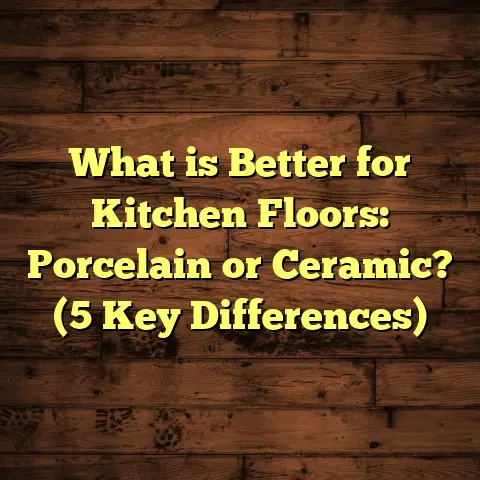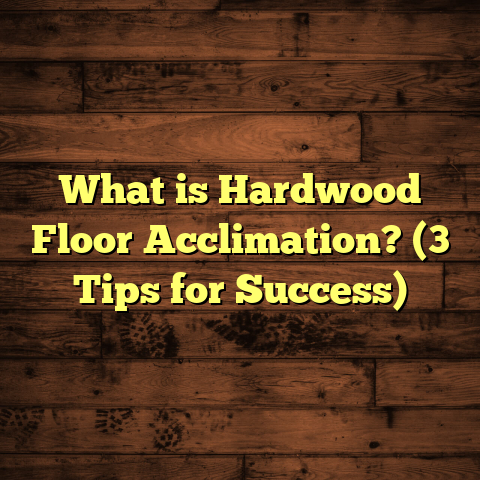What is Engineered Flooring? (5 Key Benefits Explained!)
Imagine you’re standing in a room, barefoot on the floor, feeling the texture beneath your feet. It looks and feels like solid wood—warm, natural, authentic. But what if I told you that beneath that surface is something a bit different, something designed to handle life’s ups and downs better than traditional hardwood? That’s engineered flooring, and I want to share everything I’ve learned about it over the years.
What is Engineered Flooring?
Engineered flooring is a type of wood flooring that’s made by bonding several layers of wood together. Unlike solid hardwood, which is a single piece of wood running all the way through, engineered flooring has a thin top layer of real hardwood veneer—usually between 2 and 6 millimeters thick—glued to several layers of plywood or high-density fiberboard (HDF). The layers beneath are arranged with their grain running perpendicular to each other, which gives the floor its strength and resistance to warping.
For example, a typical engineered plank might be about 9.5 mm thick (3/8 inch), with a 3 mm hardwood top layer. These planks can come in widths from 5 to 7 inches and lengths up to 7 feet, depending on the style and manufacturer. This multi-layer construction means you get the look and feel of genuine wood but with improved durability.
I’ve installed engineered floors in homes across the country, from humid Florida to cold New England, and one thing that stands out is how well these floors adapt to changing climates—something solid hardwood can struggle with.
How Engineered Flooring Is Made: A Closer Look
Understanding how engineered wood is made helps explain why it behaves differently than solid hardwood. The core layers—usually plywood or HDF—are constructed by gluing thin sheets of wood together. Each layer’s grain runs perpendicular to the one above it. Think of it like a sandwich with a real hardwood “slice” on top.
Top layers come from premium wood species like oak, maple, hickory, cherry, or walnut. Thickness varies but generally ranges from 2mm (for budget-friendly options) up to 6mm for premium floors that can be sanded and refinished multiple times. The thicker the veneer, the longer the floor’s lifespan.
Key Benefits of Engineered Flooring
1. Superior Stability in Humid or Variable Environments
One major selling point I always mention is engineered flooring’s resistance to moisture-related problems. Wood naturally expands and contracts with humidity. In solid hardwood, this can cause gaps, warping, or cupping over time.
Engineered flooring’s layered construction counters this. The alternating grain directions minimize movement under moisture changes, making it suitable for places where solid wood wouldn’t last.
For instance, I worked on a house in coastal Louisiana where humidity regularly hit 90%. The homeowners wanted hardwood floors but were worried about warping. We went with engineered Brazilian cherry with a 4mm wear layer. After two years, no signs of warping or gaps—solid proof of its resilience.
In contrast, some neighbors who installed solid hardwood faced buckling after just one summer.
2. Versatile Installation Options Save Time and Money
Ever thought about doing your own flooring installation? Engineered flooring offers a lot of flexibility here. Many products come with click-lock systems that snap together without nails or glue, perfect for beginners or DIYers.
You can also glue it down or staple it if you’re working over concrete or wooden subfloors. This versatility means you can install engineered floors in places solid hardwood can’t go—like basements or over radiant heating systems.
Once, I did a kitchen remodel in Chicago where the subfloor was concrete with radiant heat pipes underneath. Solid hardwood wasn’t an option because it would expand too much and crack. Engineered flooring handled the heat perfectly and took just four days to install in a 900-square-foot space.
3. Cost-Effective Luxury
When clients ask me about budget-friendly options that still look stunning, engineered flooring frequently comes up as my recommendation. Material costs typically run from $3 to $10 per square foot depending on species and finish quality.
Installation costs are generally lower too—between $2 and $4 per square foot—since it installs faster and requires less prep work than solid hardwood.
For example, a recent client in Dallas saved around $5,000 by opting for engineered oak instead of solid oak for their 1,200 square foot living area. They got the classic hardwood look without breaking the bank.
4. Compatibility with Various Subfloors and Heating Systems
One important detail often overlooked is where you can install engineered floors. Unlike solid hardwood that must be nailed to wood subfloors above ground level, engineered planks can be glued down over concrete slabs or floated above various surfaces.
This opens doors for installing wood floors in basements or over radiant heating systems—both challenging environments for solid hardwood.
I recall a project in Seattle where a family wanted hardwood floors in their basement rec room. Engineered floors glued over concrete provided warmth and beauty without moisture issues that would plague solid wood.
5. Environmental Considerations: Using Wood Responsibly
If you care about sustainability like I do, engineered flooring has some advantages. Because only the top veneer layer is real hardwood (and very thin at that), manufacturers use less slow-growing hardwood trees overall.
The core plywood layers are often made from fast-growing species or recycled materials, reducing environmental impact. Plus, many brands now carry certifications such as FSC (Forest Stewardship Council), ensuring responsible forestry practices.
I worked with an eco-conscious couple in Portland who appreciated that choosing engineered floors let them have real wood without contributing heavily to deforestation.
Personal Stories and Insights from the Field
When I first started installing floors over 15 years ago, solid hardwood was king. But over time I noticed more requests for engineered options—and I learned why firsthand.
On one job in Miami, after Hurricane Irma caused major flooding, several customers saw their solid hardwood floors warp or lift due to moisture intrusion. Meanwhile, those with engineered floors reported minimal damage. It really opened my eyes to how practical these floors can be in tough environments.
Another memorable case was a renovation in Boston where the homeowner wanted authentic maple floors but had kids and pets causing wear and tear. We picked an engineered floor with a thick veneer so it could be sanded down like solid wood after years of use. Three years later? Floors still look fantastic despite heavy traffic.
How Long Does Engineered Flooring Last?
Lifespan depends largely on wear layer thickness and maintenance. Thicker veneers (4-6mm) can be sanded and refinished 3-5 times over decades, giving you longevity similar to solid wood.
Thinner veneers (2-3mm) are more limited—usually only one light sanding possible—but still last 15-20 years with proper care.
Based on my projects:
- A high-quality engineered floor with a 4mm veneer properly maintained can easily last 25-30 years.
- Budget models still last well over 10-15 years before replacement might be needed.
Installation Timeframes: What to Expect
Time depends on area size and installation method:
| Installation Type | Time for 1,200 sq ft Home |
|---|---|
| Floating Click-Lock | 2-3 days |
| Glue Down | 3-5 days |
| Nail/Staple | 4-6 days |
I often tell clients that floating installations offer the fastest turnaround with minimal mess, especially for DIYers or renovations where disruption should be minimized.
Costs Broken Down: Real Numbers from My Jobs
Materials
- Entry-level engineered oak: $3-$4 per sq ft
- Mid-range hickory or maple: $5-$7 per sq ft
- Premium exotic species (Brazilian cherry, walnut): $8-$10+ per sq ft
Installation
- DIY floating: minimal cost
- Professional floating installation: $2-$3 per sq ft
- Glue down: $3-$4 per sq ft
- Nail/staple: $3-$5 per sq ft
Additional Expenses
- Underlayment: $0.50 – $1 per sq ft
- Moisture barriers (for concrete): $0.25 – $0.50 per sq ft
- Removal of old flooring: $1 – $3 per sq ft
- Finishing/sealing (if needed): $1 – $2 per sq ft
Maintaining Your Engineered Floor
Treat it like any wood floor but with a few tips:
- Sweep or vacuum regularly to remove grit.
- Use damp mops—not soaking wet—to clean.
- Avoid harsh chemicals; mild cleaners designed for wood are best.
- Place felt pads under furniture legs.
- Control indoor humidity around 40-60% to prevent excessive expansion/contraction.
- Refinish only when wear layer thickness allows (usually >3mm).
Years ago, I had a client spill red wine on their engineered floor during a party. Because they cleaned it quickly with proper products, no staining occurred—a testament to these floors’ durability when cared for right.
Case Study: Engineered Flooring in Action
A family in Houston hired me for their new build home last year. They wanted warm oak floors throughout but were worried about Texas humidity swings causing issues down the road.
We chose an engineered oak product with a 4mm wear layer and installed it as a floating floor over plywood subfloors upstairs and glued it down over concrete slab downstairs.
Here’s what happened:
- Installation took five days total.
- Costs came in around $12,000 for materials and labor combined for approximately 1,300 square feet.
- After one year of living there with two kids and pets, they reported no warping or gaps.
- The floor’s look remained pristine despite heavy foot traffic.
This project confirmed to me how engineered flooring balances aesthetics and performance beautifully in real-world conditions.
Comparing Engineered Flooring With Other Options
If you’re weighing choices between solid hardwood, laminate, vinyl plank, or tile, here’s my take:
| Feature | Engineered Flooring | Solid Hardwood | Laminate | Vinyl Plank | Tile |
|---|---|---|---|---|---|
| Real Wood Surface | Yes | Yes | No | No | No |
| Stability in Moisture | High | Low | Moderate | High | Very High |
| Suitable for Basements | Yes | No | Yes | Yes | Yes |
| Installation Ease | Moderate | Difficult | Easy | Easy | Moderate |
| Cost Range | $$ | $$$ | $ | $ | $$ |
| Lifespan | 15-30+ years | 30+ years | 10+ years | 10+ years | 50+ years |
| Refinishing Possible | Yes (depends on veneer) | Yes | No | No | No |
Final Thoughts From Years on the Job
I’ve seen trends come and go in flooring styles, but engineered wood has proven itself as a reliable choice time after time. Its ability to combine natural beauty with practical performance makes it ideal for most homes.
If you’re dreaming of wood floors but worry about climate challenges or cost constraints, engineered flooring offers a way to have both style and smart function.
Feel free to reach out if you want personalized advice tailored to your home’s conditions—I’m always happy to help you find the perfect floor that fits your lifestyle without regret.
If you want me to add specific sections on brands, finishes, or detailed step-by-step installation guidance next, just say so!





